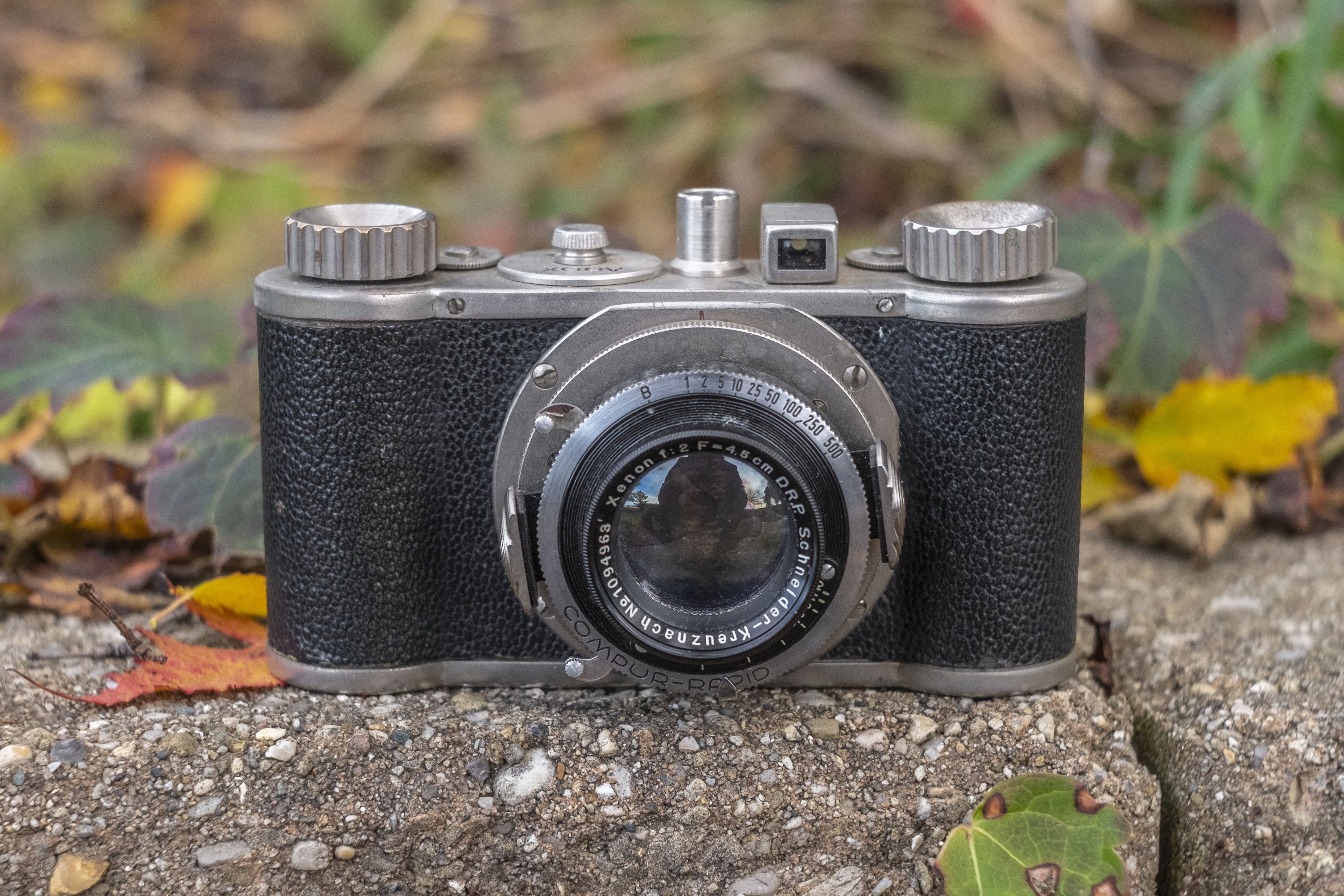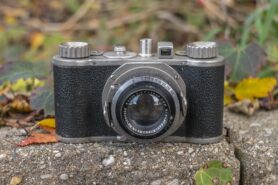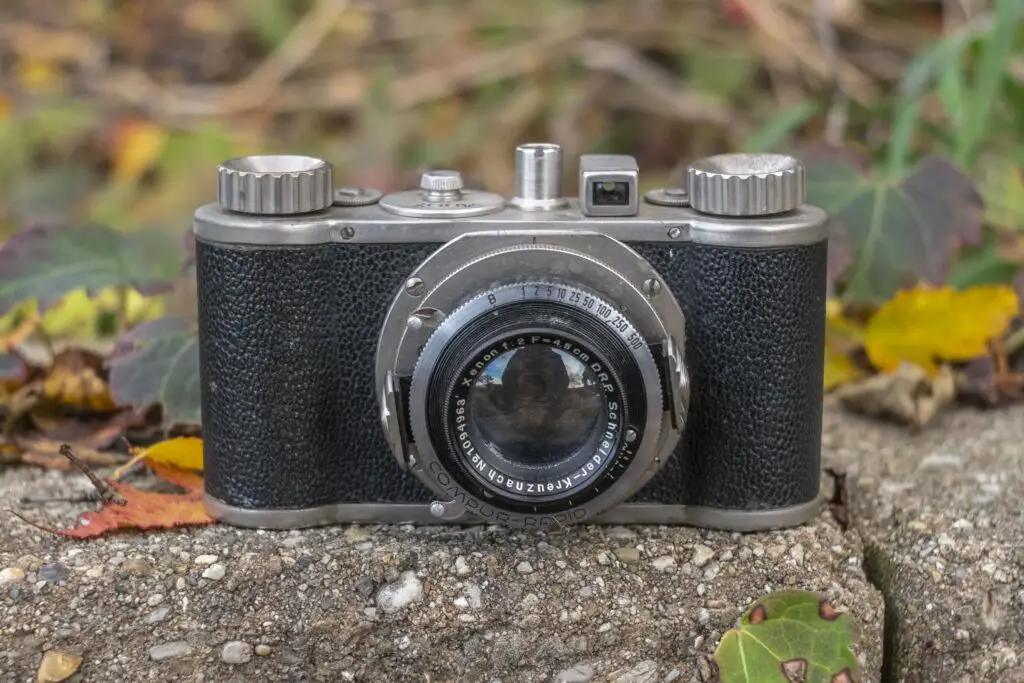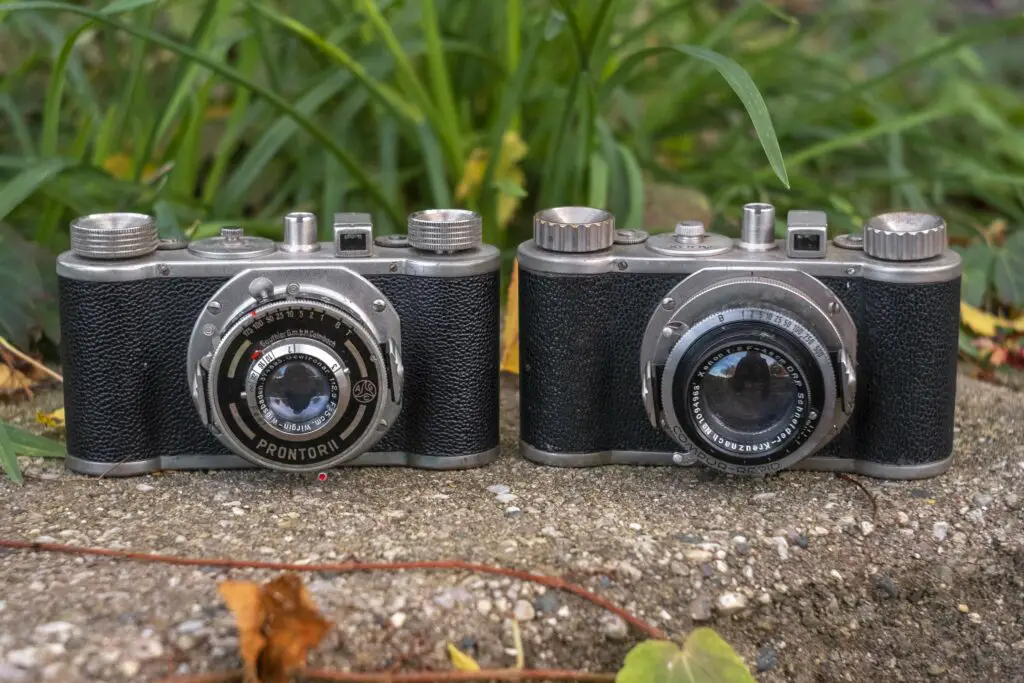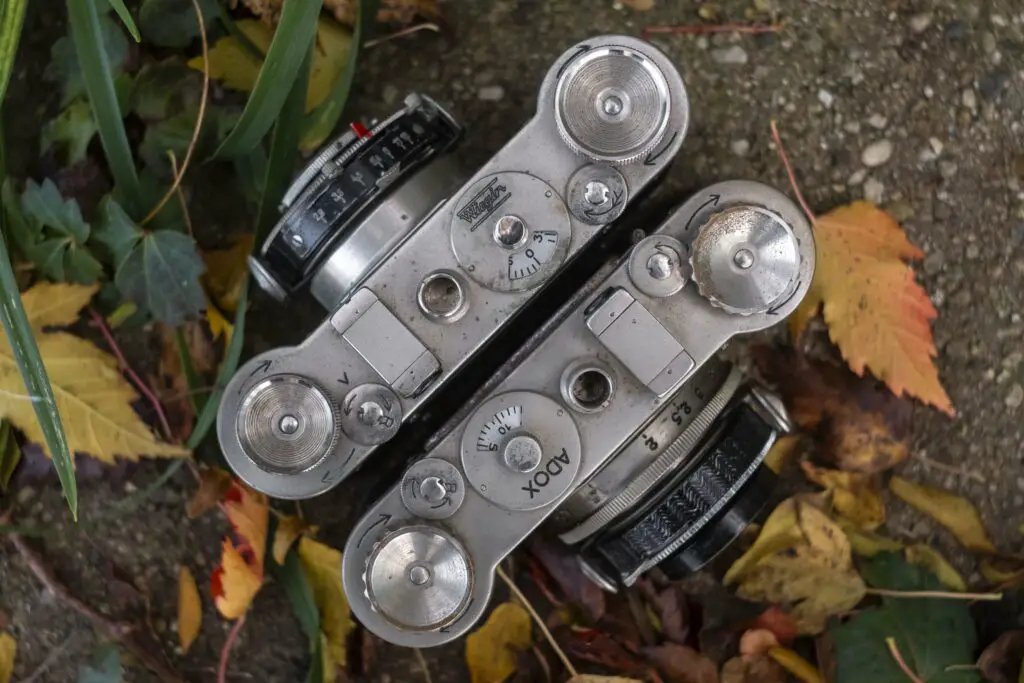This is an Adox Adrette, a 35mm scale focus camera produced by Dr. C. Schleussner Fotowerke GmbH in Frankfurt, Germany between the years 1939 and 1948. The Adox Adrette is a variant of the Wirgin Edinex, a camera first produced in 1935 by Wirgin in Wiesbaden, Germany. In 1939, the Jewish owners of Wirgin, Henry and Josef Wirgin fled Germany and their factory and all equipment fell under control of the German government. Production of the Edinex resumed as the Adox Adrette with only cosmetic changes. Despite this perilous history, the camera is very well built, very compact, and could be found with a wide selection of lenses and shutters.
Film Type: 135 (35mm)
Lens: 4.5cm f/2 Schneider-Kreuznach Xenon uncoated 6-elements in 4-groups
Focus: Variable if SLR, 2.6 feet/meters to Infinity with Click Stops for Portrait, Group, and Scenery, Auto Focus
Viewfinder: Scale Focus Optical Glass
Shutter: Compur Rapid Leaf
Speeds: B, 1 – 1/500 seconds
Exposure Meter: None
Battery: None
Flash Mount: None
Manual: None
History
Cameras and photographic equipment have been a critical part of human history for nearly 200 years. The need to freeze time and capture an image, whether etched into a tin or glass plate, a piece of light sensitive film, or a digital sensor, has been useful to nearly everyone regardless of nationality, race, color, gender, or anything else.
Sometimes though, the history of the photographic industry overlaps world history in ways we aren’t proud of. Cameras and photography are not exclusive to just “the good guys”. Sometimes, some truly terrible people had a need for a camera and in someway influenced the photographic industry.
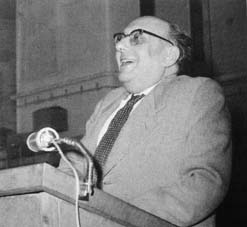

Such is the case with Heinrich and Josef Wirgin, two Jewish brothers who founded their namesake company, Wirgin in Wiesbaden in the early 1930s. Although they never reached the lofty heights of fellow German camera makers like Leitz or Zeiss-Ikon, Wirgin had several successful lineups of folding medium format and 35mm cameras. Their miniature Gewirette roll film camera proved to be very popular and shot good quality 3cm x 4cm images on 127 roll film and the 35mm Edinex was released in 1935 very shortly after Kodak’s Retina camera, making it one of the first widely produced 35mm cameras in the world.
During the era in which Wirgin was producing a large number of 35mm and medium format cameras, political and religious pressure on Jews by the German Nazi government resulted in Heinrich, Josef and a third brother Max having to flee their country for safety elsewhere, abandoning nearly everything they owned in Germany, including their company.
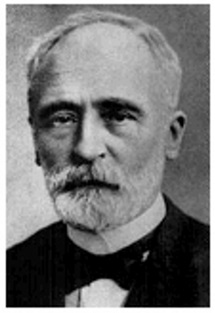
The exact circumstances of what happened next is poorly documented, but what is understood to have happened is that the local German government became aware of the abandoned Wirgin factory and a search for someone else resulted in control of the company being placed with another German company called Dr. C. Schleussner Fotowerke GmbH in Frankfurt.
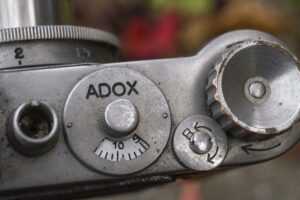
While this shift in control from Wirgin to its new owner was certainly coordinated by the Nazi government, it is worth mentioning that back then, many German citizens and companies were not Nazi sympathizers themselves, but were “discouraged” from voicing dissent or going against the wishes of their leaders. Certainly the Nazis were behind this change, but that doesnt mean the people working at Schleussner were responsible, or even happy about the change.
Nevertheless, manufacture and distribution of most of Wirgin’s models, including the Edinex were now produced by Schleussner under their Adox brand as the Adox Adrette. Apart from the name, nothing else changed.
The gallery below shows a Wirgin Edinex and Adox Adrette side by side. You’ll notice that the two cameras have different combinations of lenses and shutters and the back of the Adox has a Leica M3 style door on the back. Different combinations of lenses and shutters were common with the Wirgin as well, I just didn’t have examples of both cameras with the lens and shutter, so it should not be assumed that the Adox came with better lenses or shutters. In addition the hinged on the door back was a later change that was also available on the Wirgin Edinex both before and after the war, so it should not be assumed that this door was an Adox only feature.
As best as I can tell, Adox continued to produce the Edinex through about 1941 or 1942 at which production was halted due to the war. At some point after the war, the exact year is unknown, Heinrich and Josef would return to Germany, now using their Americanized named Henry and Joseph to regain ownership of their company. Max Wirgin would remain in the United States and would form his own distribution company which would import Wirgin cameras, along with other brands such as the Exakta.
After Henry and Joseph’s reinstatement of their company, Wirgin would resume production of the prewar Wirgin Edinex, but in 1951 would update the design with a new model still called the Edinex which collectors refer to today as the Edinex II, although Wirgin never formally used that name. A third model, equipped with a rangefinder, actually was called the Edinex III would debut around 1953.
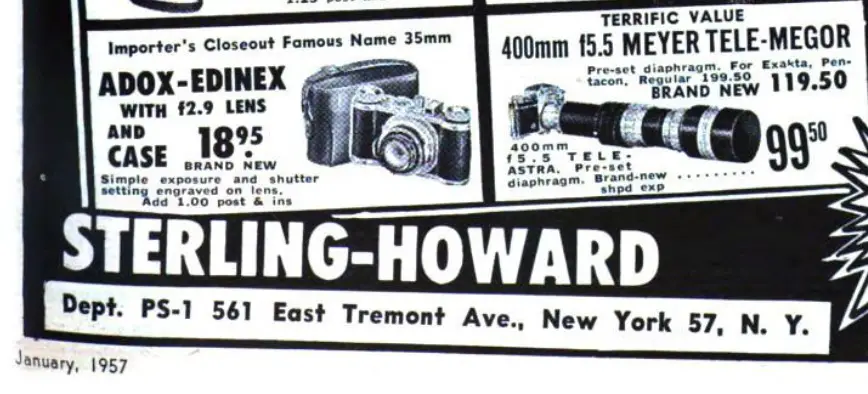
A weird twist which I really struggled to find information on, was that while Wirgin was releasing updated versions of the Edinex, Adox continued to sell the camera under their own name. Versions of the camera appeared all throughout the 1950s as the Adrette II and also as the Adox-Edinex. The ad above is from January 1957 and shows the camera for sale for $18.95 brand new. When adjusted for inflation, this price compares to about $210, making it a very affordable option. According to various sources online, new versions of the original Adox-Edinex cameras were available as late as the early 1960s. Whether or not Wirgin continued to produce the old camera for import to other countries or whether Schleussner produced them at a separate location is known. All we do know is that cameras of this same basic design were produced for quite a while, far outlasting any other Wirgin model.
My Thoughts
Always a sucked for prewar “nickel and leather” German cameras, when I saw this Adox Adrette with the Schneider 4.5cm f/2 Xenon lens for sale, in pretty good shape for a reasonable price, I had to pick it up. I already had a prewar Wirgin Edinex and had already reviewed a postwar model, so I wasn’t exactly eager to put one through it’s paces, but the camera was pretty and I didn’t have this version so I picked it up.
Like the Wirgin branded models, the camera is good looking and feels well built. Although an economical alternative to much more expensive German cameras like the Kodak Retina or Certo Dollina series, neither the Wirgin Edinex nor Adox Adrette versions feel cheap. Like the Edinex, the body is compact with rounded edges which make holding the camera very comfortable. With a collapsible lens, the camera is small enough that it easily fits into most medium pockets or small hand bags.
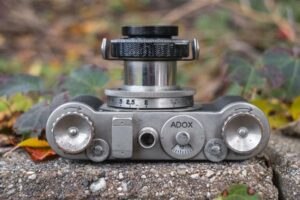
The top plate is fairly symmetrical with nickel metal knobs on either side, one on the left for rewind and the other for film advance. Immediately to the right of the rewind knob is a smaller wheel with an engraved letter R and two arrows. Turn the wheel in the direction of the R as far as it will go, and this puts the camera in rewind mode, allowing you to reverse the film transport.
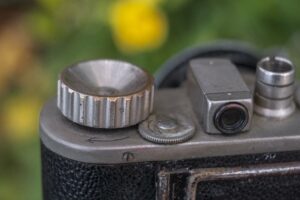
Next to that is the optical viewfinder which is nothing more than a straight through tube with two piece of glass that approximate a 5cm view that will be captured by the lens. Next to the viewfinder is a small cylindrical “tower” which is a type of accessory shoe used for early accessories like rangefinders. Prior to the more common style of accessory shoe, this type of tower was an attachment port for some early German cameras. Next is the exposure counter with reset knob in the middle. The exposure counter counts upwards from 0 showing how many exposures have been made and must be manually reset before each new exposure. On the far right is the film advance knob, with a small wheel below and to the left, similar to the rewind wheel on the other side of the top plate. This wheel is used to momentarily defeat the film advance lock. With film in the camera, the Adrette and Edinex cameras will automatically stop after 8 perforations of the 35mm film for another frame. This prevents you from overwinding the camera, wasting film. Unlike later cameras however, you cannot advance your film after making an exposure without turning this wheel in the direction of the arrow while also turning the film advance knob. For anyone who has used an Argus C3, this works exactly the same as the little post on the top plate behind the exposure counter.
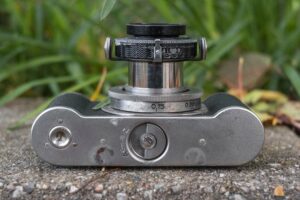
The base of the camera is the same shape as the top, just with less things to see. On the left is a 3/8″ tripod socket, whcih was the size most commonly used back then. If you were to use the Adrette with a modern tripod, you’d need to find a 3/8″ -> 1/4″ adapter. In the center is a large folding knob which acts as the bottom film door release.
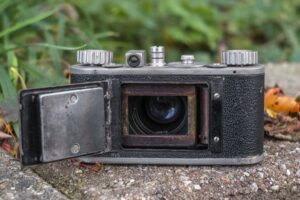
Both the Adrette and Edinexes were bottom loaders, just like the Leica, however some models like this Adrette had an M3 style inspection door that can be opened once the bottom plate has been removed. This door is truly just an inspection door for checking the alignment of the film on the sprockets, which makes loading film easier, however you cannot actually load the film through the door. You still must load it through the bottom and just use the door to make sure it is transporting correctly. Another use for this door is inspecting or cleaning the rear glass element and seeing through the shutter to make sure the timings are correct.
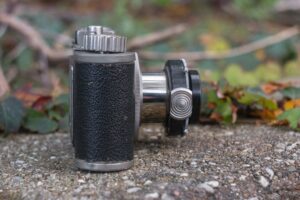
Since the Adrette is a bottom loader, there is no hinge that extends to the edge of the body making for a single curve from front to back with nothing to interrupt it, there is no latch, no flash sync ports, not even any strap bushings, which means if you wanted to use this camera with a strap, you’d either need to use the original leather case that likely came with the camera, or something that attaches to the tripod socket.
Ont thing that is very important to remember is that the Edinex has a collapsible lens, which is connected to a metal tube. The shutter is not coupled to the body, so there is no protection from allowing you to fire the shutter without first extending the lens, so you must remember to do this before making any exposures or else you will end up with a roll full of extremely out of focus images!
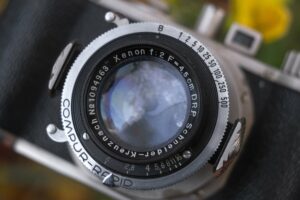
Both the Adrette and Edinexes came with a variety of different lens and shutter options, but the one on this example was a high end Compur-Rapid shutter with 4.5cm f/2 Schneider-Kreuznach Xenon lens.
Focusing the lens is done by rotating the entire front lens grouping form a minimum distance of 1 meter to infinity. A slider near the bottom of the shutter is used to control the diaphragm, with settings from f/2 to f/16, and a nickel ring around the perimeter controls shutter speeds from 1 to 1/500 seconds plus Bulb. A cocking lever is near the 10 o’clock position around the shutter with the shutter release near the 8 o’clock position. There is no self-timer or flash sync port on the camera. The arrangement of controls varies slightly based on which shutter the camera is equipped with, but the basic layout is similar between them all.
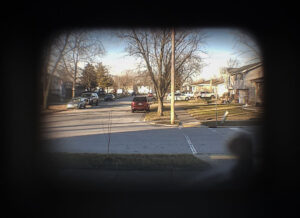
The viewfinder is basic by modern standards, but was par for the course for a 1930s 35mm camera. A simple optical design made up of two glass elements, the view through the rear eyepiece is small, yet, even while wearing prescription glasses, I could see all four edges of the frame. An interesting “feature” that may or may not have been intentional, is that when looking through the viewfinder, in the bottom right corner, you can see the shutter cocking lever when the shutter is not cocked. For regular users of this camera, being able to see this lever would have been a reminder to cock the shutter. With the shutter in the cocked position, this lever is no longer visible from the viewfinder.
The Adox Adrette and Wirgin Edinex cameras strike a perfect balance of vintage simplicity and beauty, while still being fun and capable cameras. With their “nuckel and leather” design they have an aesthetic that is highly desirable by collectors and users alike. Although lacking in many modern conveniences, these cameras are broken down to the simplest forms of photography and once you get used to the controls, offer a very relaxed shooting experience. In good lighting, the lack of TTL composition or a rangefinder is hardly an issue. Models with the Schneider Xenon lens will make excellent images that rival that of cameras costing several times the price of one of these.
Sadly, I never had a chance to shoot this camera as I had an offer to trade this Xenon equipped model to another collector, which I could not refuse. I have previously shot and reviewed a later Wirgin Edinex II with a different lens and shutter, but the shooting experience was very similar, and I have a lot of experience shooting cameras with the f/2 Xenon, so image quality would compare to those.
Related Posts You Might Enjoy
External Links
http://camera-wiki.org/wiki/Edinex
http://www.collection-appareils.fr/x/html/camera-3021-Adox_Adrette.html
http://historiccamera.com/cgi-bin/librarium2/pm.cgi?action=app_display&app=datasheet&app_id=3520&

